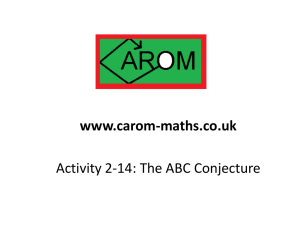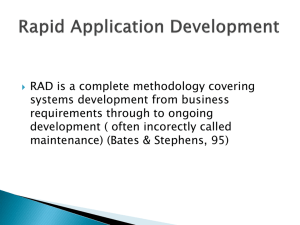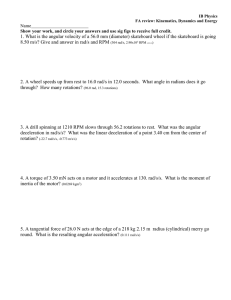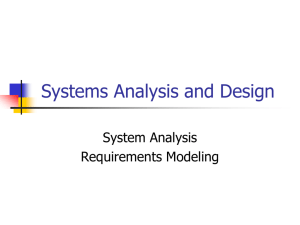New York Journal of Mathematics Florian Luca
advertisement
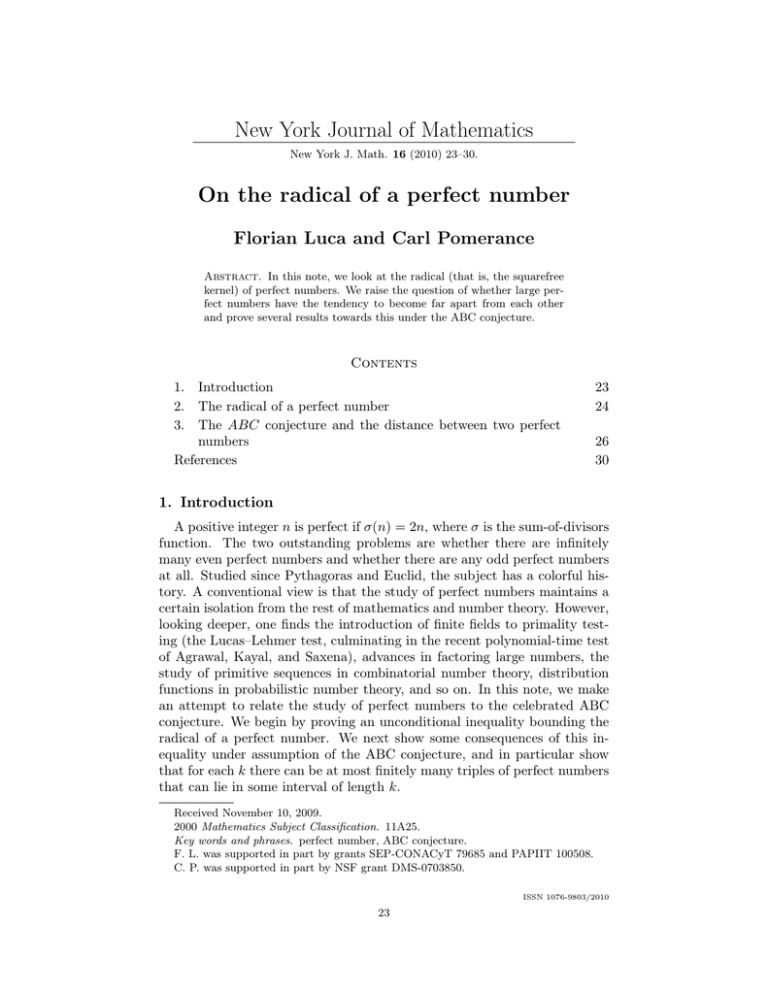
New York Journal of Mathematics
New York J. Math. 16 (2010) 23–30.
On the radical of a perfect number
Florian Luca and Carl Pomerance
Abstract. In this note, we look at the radical (that is, the squarefree
kernel) of perfect numbers. We raise the question of whether large perfect numbers have the tendency to become far apart from each other
and prove several results towards this under the ABC conjecture.
Contents
1. Introduction
2. The radical of a perfect number
3. The ABC conjecture and the distance between two perfect
numbers
References
23
24
26
30
1. Introduction
A positive integer n is perfect if σ(n) = 2n, where σ is the sum-of-divisors
function. The two outstanding problems are whether there are infinitely
many even perfect numbers and whether there are any odd perfect numbers
at all. Studied since Pythagoras and Euclid, the subject has a colorful history. A conventional view is that the study of perfect numbers maintains a
certain isolation from the rest of mathematics and number theory. However,
looking deeper, one finds the introduction of finite fields to primality testing (the Lucas–Lehmer test, culminating in the recent polynomial-time test
of Agrawal, Kayal, and Saxena), advances in factoring large numbers, the
study of primitive sequences in combinatorial number theory, distribution
functions in probabilistic number theory, and so on. In this note, we make
an attempt to relate the study of perfect numbers to the celebrated ABC
conjecture. We begin by proving an unconditional inequality bounding the
radical of a perfect number. We next show some consequences of this inequality under assumption of the ABC conjecture, and in particular show
that for each k there can be at most finitely many triples of perfect numbers
that can lie in some interval of length k.
Received November 10, 2009.
2000 Mathematics Subject Classification. 11A25.
Key words and phrases. perfect number, ABC conjecture.
F. L. was supported in part by grants SEP-CONACyT 79685 and PAPIIT 100508.
C. P. was supported in part by NSF grant DMS-0703850.
ISSN 1076-9803/2010
23
24
FLORIAN LUCA AND CARL POMERANCE
2. The radical of a perfect number
For a positive integer n we put
rad(n) =
Y
p,
p|n
where p runs over primes. The number rad(n) is called the radical of n, or
the squarefree kernel of n. Let x be a perfect number. If x is even, then by
a result of Euclid and Euler, x = 2p−1 (2p − 1) for some prime p such that
2p − 1 is also prime. Thus,
√
(1)
rad(x) = 2(2p − 1) < 8x.
Our first result in this note removes the restriction that x is even, at the
cost of a somewhat weaker inequality.
Proposition 1. The inequality
rad(x) < 2x17/26
holds for all perfect numbers x.
Proof. In light of inequality (1), we may assume that x is odd. It has been
known since Euler that x = q α m2 , where q ≡ 1 (mod 4) is a prime, α ≡ 1
(mod 4), and m is coprime to q. Obviously
1/2
x
(2)
rad(x) ≤ qm = q
= x1/2 q 1−α/2 .
qα
So, if α 6= 1, it then follows that rad(x) < x1/2 . Assume now that α = 1,
therefore qkx. By (2), we may also assume that q ≥ 4x4/13 .
Since x is perfect, there is a prime power p2a kx with q | σ(p2a ). Write x
as qp2a v 2 . Suppose that p - σ(q), so that qp2a | σ(p2a v 2 ). Thus,
qp2a < 2p2a v 2 ;
that is,
v > (q/2)1/2 .
Also, since p is an odd prime,
3
q ≤ σ(p2a ) < p2a ,
2
so
pa > (2q/3)1/2 .
Thus,
(3)
rad(x) ≤
x
p2a−1 v
≤
x
x
< 31/2 .
a
p v
q
Next, consider the case when p | σ(q) = q + 1. Then q ≡ −1 (mod p), and
since σ(p2a ) ≡ 1 (mod p), we have σ(p2a ) = qu, where u ≡ −1 (mod p). In
particular, this forces q, u ≥ 2p − 1 (and so a ≥ 2). In any event, we have
q ≤ σ(p2a )/(2p − 1) < p2a−1 , so that
x
x
rad(x) ≤ 2a−1 < ,
p
q
and (3) holds in this case as well.
ON THE RADICAL OF A PERFECT NUMBER
25
By (3), we may assume that q is not too large, so that with our earlier
assumed lower bound for q, we have
(4)
4x4/13 ≤ q < x9/26 .
Factor pa v as nk where (n, k) = 1, n is squarefree, and k is squarefull (i.e.,
each prime dividing k appears with exponent at least 2). Thus, x = qn2 k 2 .
It follows that n = (x/q)1/2 k −1 , so by (4),
rad(x) ≤ qnk 1/2 = (qx)1/2 k −1/2 < x35/52 k −1/2 .
Therefore, we are done unless
(5)
k2 <
1 1/13
x
.
16
Since (5) implies σ(k 2 ) < 81 x1/13 , we have q - σ(k 2 ) by the lower bound in
(4). Thus, q | σ(n2 ); that is, p2a kn2 and a = 1. By the observation above,
this forces p - σ(q).
Since (using p odd and (4))
2
8
2
(6)
p2 > σ(p2 ) ≥ q ≥ x4/13 ,
3
3
3
2
we have by (5) that p - σ(k ), so either
(i) p2 | σ(r2 ) for some prime r | n, or
(ii) p | σ(r2 ), p | σ(s2 ) for some primes r, s | n, r 6= s.
In case (i),
2
16
2
r2 > σ(r2 ) ≥ p2 ≥ x4/13 ,
3
3
9
using (6). Then
8
16
512 12/13
qp2 r2 > 4x4/13 · x4/13 · x4/13 =
x
,
3
9
27
so σ(x/qp2 r2 ) < (27/256)x1/13 which is too small to be divisible by r. Thus,
qp2 r2 | σ(qp2 r2 ), which implies that σ(qp2 r2 )/qp2 r2 is an integer in the
interval (1, 2]; that is, it is 2 and x = qp2 r2 is perfect. But by a theorem of
Sylvester [4], each odd perfect number has at least 5 distinct prime factors.
Thus, case (i) does not occur.
If we are in case (ii), then again by (6),
2
2
2
32
2
r2 > σ(r2 ) ≥ p and s2 > σ(s2 ) ≥ p, so r2 s2 > x4/13 .
3
3
3
3
27
Hence, by (4) and (6),
8
32
1024 12/13
qp2 r2 s2 > 4x4/13 · x4/13 · x4/13 =
x
.
3
27
81
So σ(x/qp2 r2 s2 ) < (81/512)x1/13 , which is too small to be divisible by r
or s, which are each larger than x1/13 . Hence, qp2 r2 s2 | σ(qp2 r2 s2 ), which
implies as above that x = qp2 r2 s2 is perfect. This contradicts Sylvester’s
26
FLORIAN LUCA AND CARL POMERANCE
theorem quoted above, so this case does not occur either. We conclude that
the proposition holds.
3. The ABC conjecture and the distance between two
perfect numbers
Luca proposed as a problem (see [3]) to prove that two consecutive numbers cannot be both perfect. This raises the question of whether perfect
numbers should be far apart from each other. More formally, given k 6= 0,
is it true that the equation
(7)
x−y =k
has only finitely many solutions in perfect numbers x and y? This is clear if
x and y are both even since even perfect numbers are, in particular, members
of a binary recurrent sequence so they increase at an exponential rate, but
what if one is even and one is odd, or if both are odd? In what follows,
we prove some conditional results on this problem. Recall that the ABC
conjecture asserts that for each ε > 0 there exists a constant Cε depending
only on ε such that whenever a, b and c are coprime nonzero integers with
a + b = c the inequality
max{|a|, |b|, |c|} ≤ Cε rad(abc)1+ε
holds.
Proposition 2. The ABC conjecture implies that for every odd integer k,
the equation
x−y =k
has only finitely many solutions in perfect numbers x and y.
Proof. Let us assume that there are solutions to the equation x − y = k in
perfect numbers x and y with an arbitrarily large x.
We use the following well-known consequence of the ABC conjecture: Let
f (X) ∈ Z[X] be a polynomial of degree d ≥ 1 without repeated roots. Fix
ε > 0. Then the ABC conjecture implies that
(8)
rad(f (n)) |n|d−1−ε .
The implied constant here depends on the polynomial f (X) and ε. For a
proof of this result, see [1] or [2]. 1
Since k is odd, if follows that one of the numbers x and y is odd and
the other is even. Up to changing k to −k, we may assume that x is even.
Assume that x = 2p−1 (2p − 1). Let d be some fixed positive integer to be
chosen later. There are nonnegative integers a, t with a < d and p = a + dt.
Then
y = x − k = 22p−1 − 2p−1 − k = 22a−1 m2d − 2a−1 md − k,
1We recall that the expressions A B and B A are synonymous with A = O(B).
ON THE RADICAL OF A PERFECT NUMBER
27
where m := 2t . Let us take a look at the polynomial
f (X) = 22a−1 X 2d − 2a−1 X d − k.
We shall show that it has no repeated roots. Note that
f 0 (X) = d22a X 2d−1 − d2a−1 X d−1 = d2a−1 X d−1 (2a+1 X d − 1).
Thus, assuming that z is a double root of f (X), we then get that
z d−1 (2a+1 z d − 1) = 0.
Clearly, z 6= 0 because f (0) = −k 6= 0. Thus, z d = 2−a−1 , and now for such
z we have
f (z) = 2a−1 z d (2a z d − 1) − k = 2−2 (2−1 − 1) − k = −2−3 − k 6= 0.
Thus, the polynomial f (X) has only simple roots. By (8) and x m2d , it
follows that
(9)
rad(y) = rad(f (m)) m2d−1−ε = (m2d )1−1/2d−ε/2d x1−1/2d−ε/2d .
However, assuming say that x > 2|k|, it follows that y x, and by Proposition 1, we get that
(10)
rad(y) y 17/26 x17/26 .
Putting together relations (9) and (10), we get
x17/26 x1−1/2d−ε/2d .
Taking d = 3 and ε = 1, we get that x = O(1), contradicting that x was
arbitrarily large. This completes the proof of Proposition 2.
We give another result in the same spirit as Proposition 2.
Proposition 3. The ABC conjecture implies that for every nonzero integer
k, the equation
x−y =k
has only finitely many solutions in squarefull perfect numbers x and y.
Proof. Observe first that since even perfect numbers are never squarefull,
it follows that x and y are both odd. Without restricting the generality, we
may assume that k > 0 (otherwise we replace k by −k), and that y > k.
Thus, y < x < 2y. Observe that if x = p1+4ap m2 and y = q 1+4bq n2 , then
ap ≥ 1 and bq ≥ 1. Write
(11)
x = u 2 m1
and
y = v 2 n1 ,
where u and v are squarefree and m1 and n1 are fourth power full, meaning
that whenever r is a prime factor of m1 (or n1 ), then r4 | m1 (or r4 | n1 ),
respectively. Observe that
x 1/4
1/4
rad(x) ≤ um1 = u 2
= u1/2 x1/4 ,
u
28
FLORIAN LUCA AND CARL POMERANCE
and similarly
rad(y) ≤ v 1/2 y 1/4 v 1/2 x1/4 .
Let D := gcd(x, y). Then D | k, and
x
y
k
(12)
−
= .
D D
D
The ABC conjecture applied to equation (12) shows that
x
x
≤
(rad(x)rad(y))1+ε (uv)1/2+ε x1/2+ε (uv)1/2 x1/2+2ε ,
k
D
where we used the fact that u ≤ x1/2 and v ≤ y 1/2 x1/2 . Thus,
x1−4ε uv,
(13)
where the constant implied in the above Vinogradov symbol depends on
both ε and k.
We shall now choose ε > 0 in the following way. First choose a number
T so large that 3T > k. Next choose ε > 0 so small that 17 · 3T +1 ε < 1/2.
From, now on, we will work under this assumption. Since both v x1/2
and u ≤ x1/2 hold, from the above inequality (13) we read that
u x1/2−4ε ,
v x1/2−4ε ,
and
and by equations (11) we learn that m1 x8ε and n1 x8ε . Now
2u2 m1 = 2x = σ(x) = σ(u2 )σ(m1 ),
and σ(m1 ) ≤ 2m1 x8ε . This shows that gcd(u2 , σ(u2 )) x1−16ε . Similarly, gcd(v 2 , σ(v 2 )) x1−16ε . Write
U0 = gcd(u2 , σ(u2 )) =
t
Y
pai i ,
V0 = rad(U0 )2 ,
W0 =
i=1
x
,
V0
where ai ∈ {1, 2} for i = 1, . . . , t.
We next show that t ≥ T + 1 holds assuming that x is sufficiently large.
Indeed observe that V0 and W0 are coprime. Assume that there exists a
prime dividing gcd(U0 , σ(W0 )) which we take to be p1 . Then
p1 ≤ σ(W0 ) ≤ 2W0 = 2x/V0 ≤ 2x/U0 < c1 x16ε ,
where c1 > 0 is some constant depending on k and ε. Assuming that x is
sufficiently large, we have that max{p1 , W0 } < 2x17ε . Let
t
U1 =
Y a
U0
pi i ,
a1 =
p1
V1 = rad(U1 )2 ,
W1 =
i=2
x
= W0 p21 ≤ 23 x51ε .
V1
Assume next that there is a prime dividing gcd(U1 , σ(W1 )) which we take
to be p2 . Then p2 ≤ 2W1 ≤ 24 x51ε . Repeating the above construction, we
get
t
Y a
U1
U2 = a2 =
pi i ,
p2
i=3
V2 = rad(U2 )2 ,
W2 =
x
= W1 p22 ≤ 211 x153ε .
V2
ON THE RADICAL OF A PERFECT NUMBER
29
Let us continue in this way. Then at step j, where 1 ≤ j ≤ t, we end up
with the three numbers
t
Y
x
j−1
j
Uj =
pai i , Vj = rad(Uj )2 , Wj =
= Wj−1 p2j ≤ 24·3 −1 · x17·3 ε .
Vj
i=j+1
Assume that we have reached some j ≤ T + 1 such that for i ∈ {j + 1, . . . , t}
we have that no pi divides σ(Wj ). Then since σ(Vj Wj ) = σ(Vj )σ(Wj ) =
2Vj Wj (observe that Vj and Wj are coprime), we get that each p2i | σ(Vj ).
This shows that Vj | σ(Vj ). In particular, either Vj is perfect, which is
false since Vj = rad(Uj )2 is a square, and there are no “perfect squares”, or
Vj = 1, which is again false for large x because
Vj ≥ 2−4·3
j−1 −1
x1−17·3
jε
≥ 2−4·3
T −1
x1−17·3
T +1 ε
≥ 2−4·3
T −1
x1/2 > 1,
where the last inequality holds for large enough x. So, the conclusion is that
the above process must continue at least until j > T + 1 is reached. Thus,
ω(U0 ) = t ≥ j ≥ T + 1. Now every prime pi dividing U0 also divides σ(u2 ),
so it divides q 2 + q + 1 for some prime q | u. Thus, either pi = 3, or pi ≡ 1
(mod 3). Thus, u has at least T distinct primes p ≡ 1 (mod 3) and such
that p2 kx; therefore 3T | σ(x) = 2x, so 3T | x.
A similar argument shows that 3T | y. Hence, 3T | (x − y) = k, which is
false, because 3T > k.
Let (an )n≥1 be the increasing sequence of perfect numbers. While we
cannot prove in its full generality that for every fixed positive integer k the
equation
an+1 − an ≤ k
has only finitely many solutions, we can show that there are no three perfect
numbers close together infinitely often assuming again the ABC conjecture.
Proposition 4. Under the ABC conjecture, for every fixed positive integer
k the inequality
an+2 − an ≤ k
has only finitely many solutions n.
Proof. Assume that 2 ≤ k1 < k2 ≤ k are fixed and that an+1 = an + k1
and an+2 = an + k2 . Let x := an . Consider the polynomial
f (X) = X(X + k1 )(X + k2 ),
which obviously has only simple roots. By (8), we have that
rad(an an+1 an+2 ) = rad(f (x)) x2−ε .
On the other hand, by Proposition 1, we have that
rad(an an+1 an+2 ) ≤ rad(an )rad(an+1 )rad(an+2 ) ≤ 8x51/26 .
Thus, x51/26 x2−ε , and choosing ε = 1/27, we get that x = O(1).
30
FLORIAN LUCA AND CARL POMERANCE
Acknowledgements. The authors thank the anonymous referee for comments which improved the quality of the paper. They also thank Bill Banks,
Kevin Ford, Hendrik Lenstra, and Paul Pollack for useful suggestions.
References
[1]
[2]
[3]
[4]
Elkies, Noam D. ABC implies Mordell. Internat. Math. Res. Notices 1991, no.
7, 99–109. MR1141316 (93d:11064), Zbl 0763.11016.
Langevin, Michel. Partie sans facteur carré de F (a, b) (modulo la conjecture
(abc)). Séminaire de Théorie des Nombres (1993–1994), Publ. Math. Univ. Caen,
1995.
Luca, Florian. Problem 10711. Amer. Math. Monthly 106 (1999) 781–782; solution 108 (2001) 80–81. MR1543406, MR1543804.
Sylvester, James Joseph. Sur l’impossibilité de l’existence d’un nombre parfait
impair qui ne contient pas au moins 5 diviseurs premiere distincte, Compte Rendus
CVI (1888), 522–526. JFM 20.0173.04
Instituto de Matemáticas, Universidad Nacional Autonoma de México, C.P.
58089, Morelia, Michoacán, México
fluca@matmor.unam.mx
Mathematics Department, Dartmouth College, Hanover, NH 03755, USA
carl.pomerance@dartmouth.edu
This paper is available via http://nyjm.albany.edu/j/2010/16-3.html.
